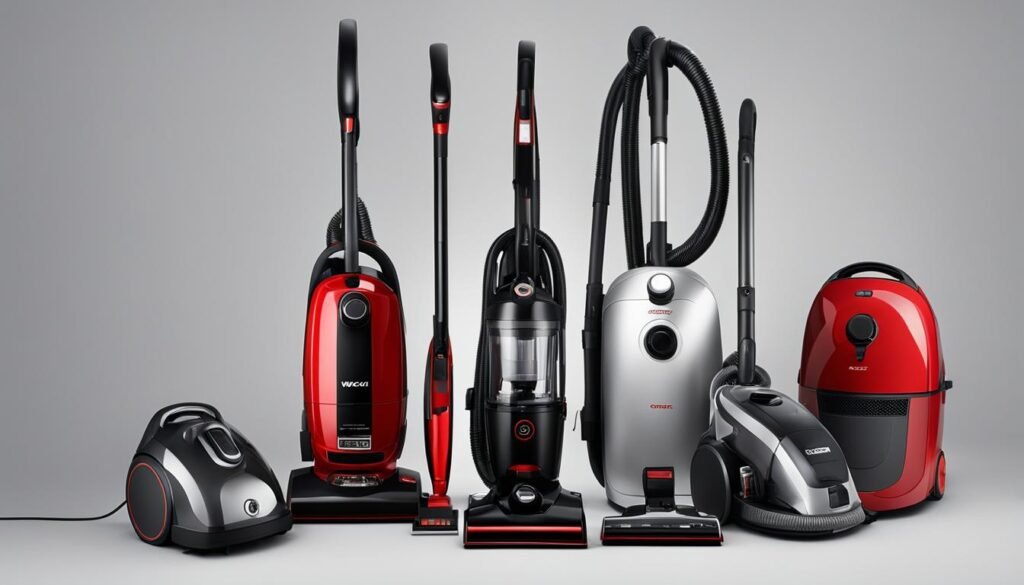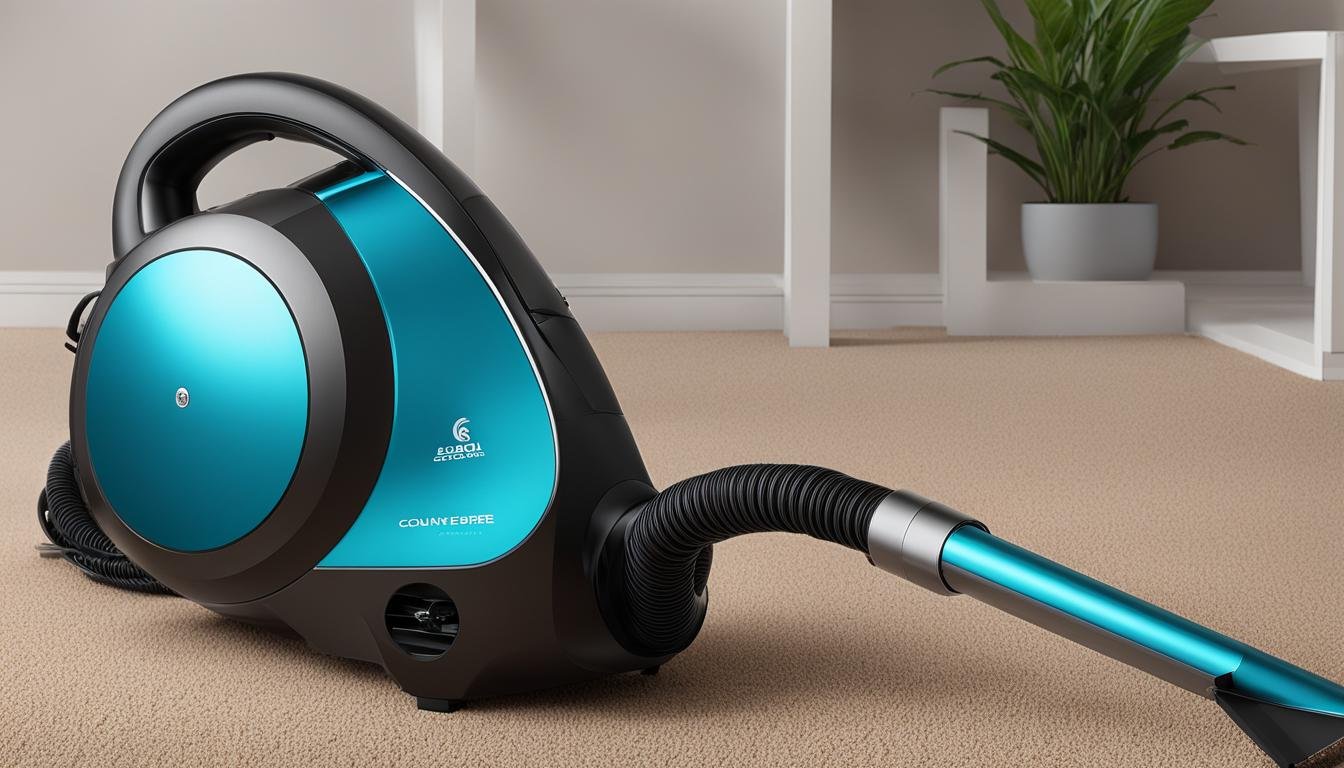When it comes to keeping our homes clean and dirt-free, one device that immediately comes to mind is the vacuum cleaner. But what exactly is a vacuum cleaner and why is it significant in our cleaning routines?
A vacuum cleaner, also known simply as a vacuum, is an electrically driven appliance that uses suction to remove dirt from floors, upholstery, draperies, and other surfaces. It is a versatile cleaning tool available in various sizes and models, catering to different cleaning needs. From handheld devices to canister models, central vacuum cleaners to industrial appliances, and even self-propelled vacuum trucks, there is a vacuum cleaner designed for every situation.
The term “vacuum cleaner” is often used interchangeably with the word “vacuum.” It is worth noting that in some countries, the term “hoover” is used as a generic trademark and verb for vacuum cleaners. Regardless of the name used, the main purpose of a vacuum cleaner remains the same – to effectively remove both solid matter and liquids, making cleaning tasks easier and more efficient.
Key Takeaways:
- A vacuum cleaner is an electrically driven device that uses suction to remove dirt from various surfaces.
- It comes in different sizes and models, including handheld devices, canister models, central vacuum cleaners, and industrial appliances.
- The term “vacuum cleaner” is often used interchangeably with the word “vacuum.”
- Vacuum cleaners are capable of removing both solid matter and liquids.
- Understanding the meaning and significance of vacuum cleaners helps in choosing the right one for our cleaning needs.
History of Vacuum Cleaners
The evolution of vacuum cleaners has seen significant advancements since their inception in the 19th century. Initially, manual vacuum cleaners were invented in the 1860s and relied on bellows or blowing air to gather dust. However, with the advent of the 20th century, motorized vacuum cleaners became more prevalent, marking a notable milestone in cleaning technology.
One of the key breakthroughs in the history of vacuum cleaners was the invention of electric-powered models. Inventors such as James B. Kirby and James Murray Spangler played critical roles in revolutionizing the industry by introducing the convenience and power of electricity to cleaning devices. Since then, electric-powered vacuum cleaners have become the norm, making household cleaning more efficient and effortless.
Post-Second World War developments brought about significant changes in vacuum cleaner technology. With the rise of the middle class, vacuum cleaners became more accessible and popular among households. These developments led to the evolution of domestic vacuum cleaners, catering to the specific needs of residential users.
In recent years, the vacuum cleaner industry has witnessed remarkable advancements, driven by technological innovations. Filterless cyclonic dirt separation technology has been introduced, providing improved cleaning performance and eliminating the need for conventional filters. Central vacuum systems have also gained popularity, offering convenient and powerful cleaning solutions for homes and commercial spaces. Additionally, rechargeable handheld vacuums and autonomous robotic vacuum cleaners have emerged as recent developments, providing users with enhanced flexibility and automation in their cleaning routines.
“The history of vacuum cleaners showcases the progression from manual devices to electric-powered models, ultimately leading to advanced technological features that we see today.”
Post-Second World War Developments in Vacuum Cleaners
After World War II, the vacuum cleaner industry experienced significant growth and innovation. The increased demand for household appliances, including vacuum cleaners, drove manufacturers to refine and improve their products. These post-war developments focused on making vacuum cleaners more affordable, efficient, and user-friendly for the growing middle-class population.
Recent Developments in Vacuum Cleaner Technology
In recent years, vacuum cleaner technology has continued to evolve, bringing forth impressive advancements. Some noteworthy recent developments include:
- Filterless cyclonic dirt separation technology: This innovation improves suction power, reduces maintenance, and enhances overall cleaning performance.
- Central vacuum systems: These systems offer powerful, whole-home cleaning solutions with the advantage of minimizing noise and allergens inside the living space.
- Rechargeable handheld vacuums: These portable and cordless devices provide convenience and maneuverability for quick cleaning tasks.
- Autonomous robotic vacuum cleaners: These intelligent devices navigate and clean homes independently, saving time and effort for users.
The recent developments in vacuum cleaner technology have transformed the way we approach cleaning, making it more efficient, automated, and tailored to individual needs.
| Type of Vacuum Cleaner | Description |
|---|---|
| Manual Vacuum Cleaners | Invented in the 1860s, these early vacuum cleaners relied on bellows or blowing air to gather dust. |
| Powered Vacuum Cleaners | In the early 20th century, motorized vacuum cleaners were developed, paving the way for more efficient and convenient cleaning. |
| Domestic Vacuum Cleaners | Post-Second World War developments led to the creation of vacuum cleaners specifically designed for household use, meeting the needs of residential users. |
| Recent Developments | Advancements in technology have given rise to filterless cyclonic dirt separation, central vacuum systems, rechargeable handheld vacuums, and autonomous robotic vacuum cleaners. |
Types and Configurations of Vacuum Cleaners
When it comes to vacuum cleaners, there is no one-size-fits-all solution. These cleaning devices come in various types and configurations, each designed to meet specific cleaning needs. Let’s explore the different options available:
Upright Vacuum Cleaners
Upright vacuum cleaners are a popular choice in the US, UK, and many Commonwealth countries. They are easy to maneuver, thanks to their vertical design, and typically feature a rotating brushroll or beater bar for effective dirt removal.
Dirty-Air/Direct Fan Vacuum Cleaners
Dirty-air/direct fan vacuum cleaners are a type of upright vacuum cleaner. They use a large impeller (fan) to blow dirt into a receptacle. While these models may require more frequent filter changes, they are known for their powerful suction capabilities.
Clean-Air/Fan-Bypass Vacuum Cleaners
Clean-air/fan-bypass vacuum cleaners, also known as clean-air systems, have the motor mounted after the filter bag. This configuration results in better suction power as the airflow is not obstructed. These vacuum cleaners are often preferred for their ability to maintain consistent performance even when the dust bag is full.
Other Configurations
In addition to upright vacuum cleaners, there are several other configurations available:
- Canister Models: Canister vacuum cleaners feature a separate canister unit connected to a wand and cleaning head. They offer versatility, with the ability to clean various surfaces and hard-to-reach areas.
- Central Vacuum Systems: Designed for larger homes or commercial spaces, central vacuum systems consist of a central unit that is installed in a utility area. These systems provide powerful and convenient cleaning, with the dirt and debris being collected in a central receptacle.
- Portable or Hand-Held Vacuums: These compact vacuum cleaners are lightweight and easy to carry, making them perfect for quick clean-ups and reaching tight spaces. They are great for cars, small apartments, and areas with limited storage.
Choosing the right type and configuration of vacuum cleaner depends on factors such as your cleaning requirements, the size of your space, and personal preference. Consider the type of surfaces you need to clean, the features that matter most to you, and your budget.
| Vacuum Cleaner Type | Main Features |
|---|---|
| Upright Vacuum Cleaners | – Popular design – Rotating brushroll – Easy maneuverability |
| Dirty-Air/Direct Fan Vacuum Cleaners | – Powerful suction – Large impeller (fan) – Effective dirt removal |
| Clean-Air/Fan-Bypass Vacuum Cleaners | – Better suction power – Motor mounted after filter bag – Consistent performance |
| Canister Models | – Versatility – Separate canister unit – Reach hard-to-reach areas |
| Central Vacuum Systems | – Powerful and convenient cleaning – Central unit installation – Centralized dirt collection |
| Portable or Hand-Held Vacuums | – Compact and lightweight – Easy to carry – Ideal for quick clean-ups |

Now that you are familiar with the various types and configurations of vacuum cleaners, you can make an informed decision based on your specific cleaning needs. Whether you prefer the power and convenience of an upright vacuum cleaner or the versatility of a canister model, there is a vacuum cleaner out there to help you keep your space clean and tidy.
Conclusion
In summary, the vacuum cleaner is an indispensable device that has revolutionized the way we clean our homes. Its powerful suction capabilities are essential in effectively removing dirt and debris from various surfaces, making cleaning tasks more efficient and convenient.
From the early manual vacuum cleaners to the modern electric-powered and robotic models, vacuum cleaners have evolved significantly in terms of functionality and convenience. Today, they are widely used in both residential and industrial settings, playing a crucial role in maintaining cleanliness and hygiene.
Understanding the meaning of a vacuum cleaner and familiarizing ourselves with its different types and configurations allows us to make informed decisions when selecting the right vacuum cleaner for our cleaning needs. Whether it’s an upright vacuum cleaner, a canister model, or a portable handheld device, choosing the appropriate vacuum cleaner is key to achieving optimal cleaning results.
The importance of a vacuum cleaner cannot be overstated in our cleaning routines. It saves us time and effort, ensuring that our living spaces remain clean and free from allergens and pollutants. Incorporating a vacuum cleaner into our cleaning regimen is an essential step towards creating a healthy and comfortable environment for ourselves and our families.
FAQ
What is a vacuum cleaner?
A vacuum cleaner, also known as a vacuum, is a device that uses suction to remove dirt from various surfaces such as floors, upholstery, and draperies. It is an electrically driven appliance available in different sizes and models.
How does a vacuum cleaner work?
Vacuum cleaners work by creating suction that pulls in dirt and debris. The suction is generated by an electric motor, and the dirt is collected in a bag or a canister. Some models also have rotating brushes or beater bars to help dislodge dirt from carpets and other surfaces.
What are the different types of vacuum cleaners?
There are several types of vacuum cleaners available. The most common types include upright vacuum cleaners, canister models, central vacuum systems, and portable or handheld vacuums.
What is the difference between dirty-air/direct fan and clean-air/fan-bypass vacuum cleaners?
Dirty-air/direct fan vacuum cleaners use a large impeller (fan) to blow dirt into a receptacle, while clean-air/fan-bypass vacuum cleaners have the motor mounted after the filter bag, resulting in better suction power.
Are there vacuum cleaners specifically designed for industrial use?
Yes, there are vacuum cleaners specifically designed for industrial use. These industrial appliances and self-propelled vacuum trucks are capable of handling heavy-duty cleaning tasks in large commercial or industrial spaces.
Can vacuum cleaners clean both solid matter and liquids?
Yes, vacuum cleaners are versatile cleaning tools that can handle both solid matter and liquids. However, it is essential to check the specific model’s capabilities and features to ensure it is suitable for wet cleaning.
How do advancements in technology impact vacuum cleaners?
Advances in technology have led to significant improvements in vacuum cleaners. These include features such as filterless cyclonic dirt separation, rechargeable handheld vacuums, and even autonomous robotic vacuum cleaners that can clean floors without human intervention.






Leave a Reply